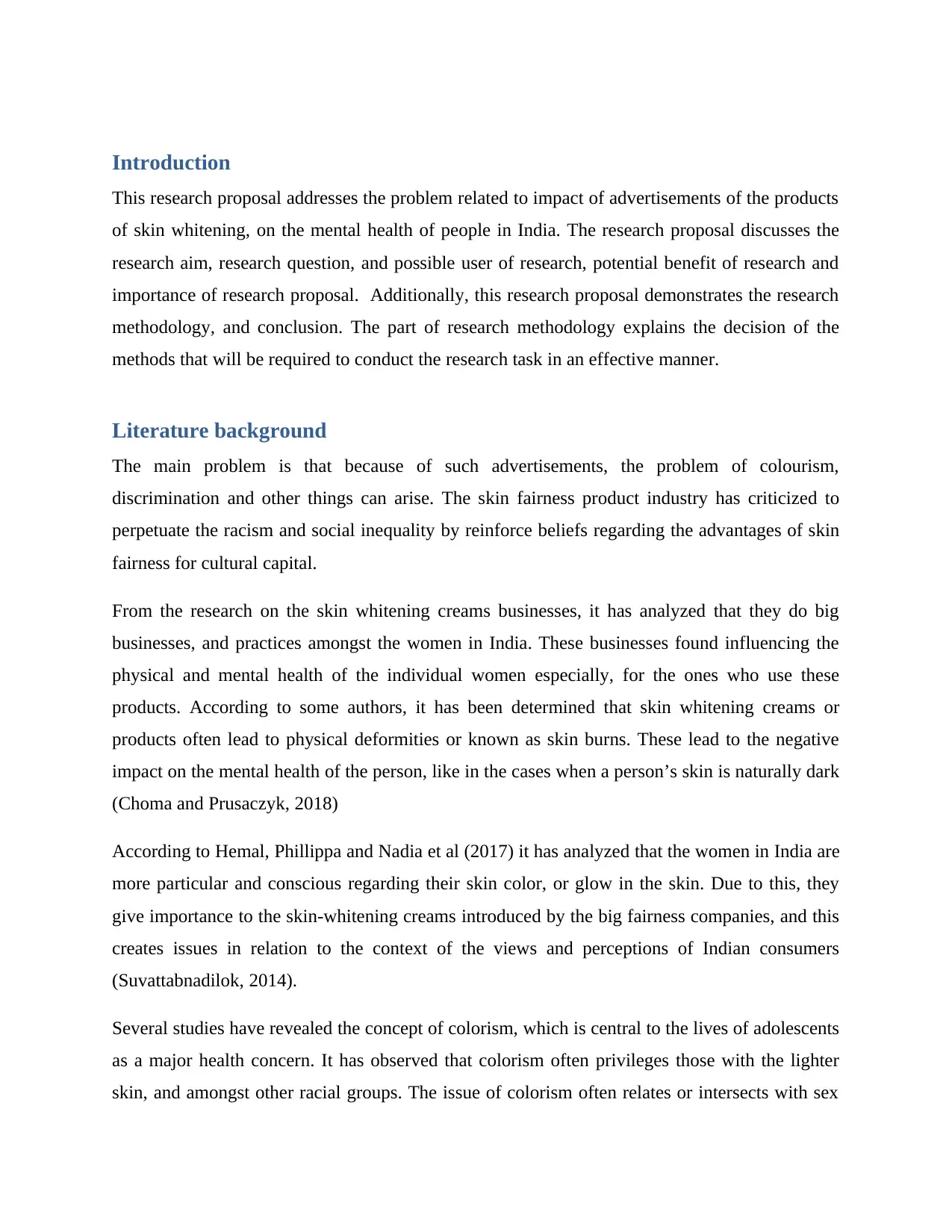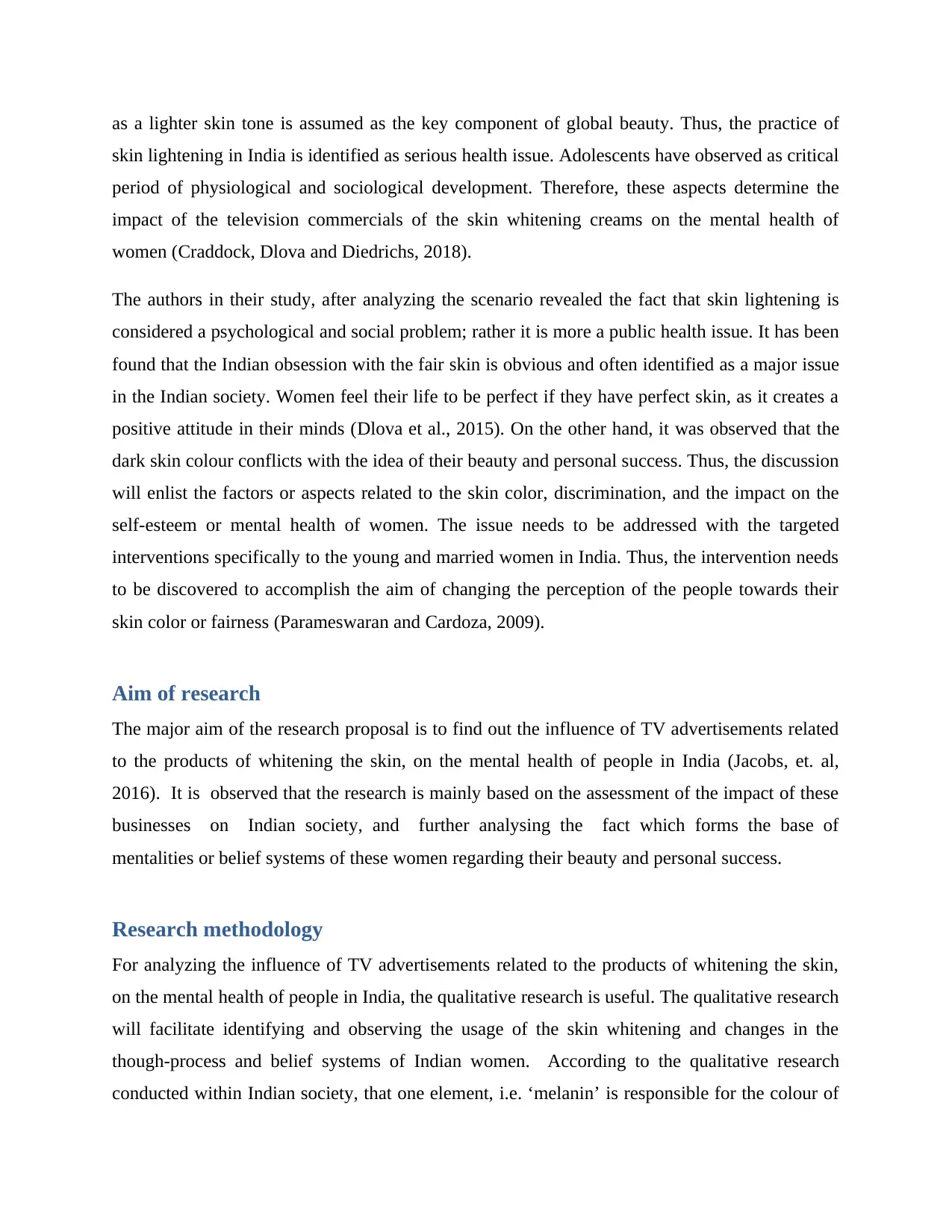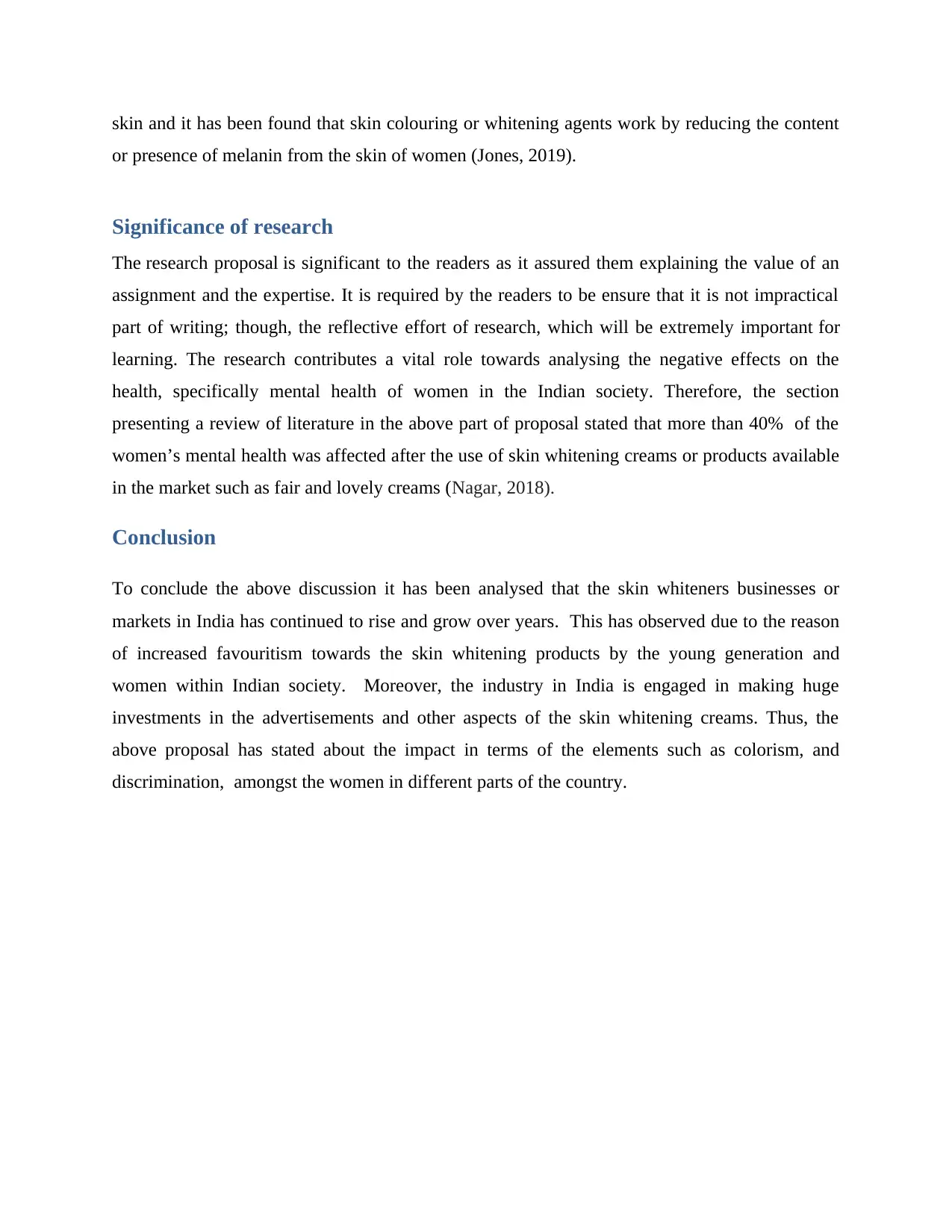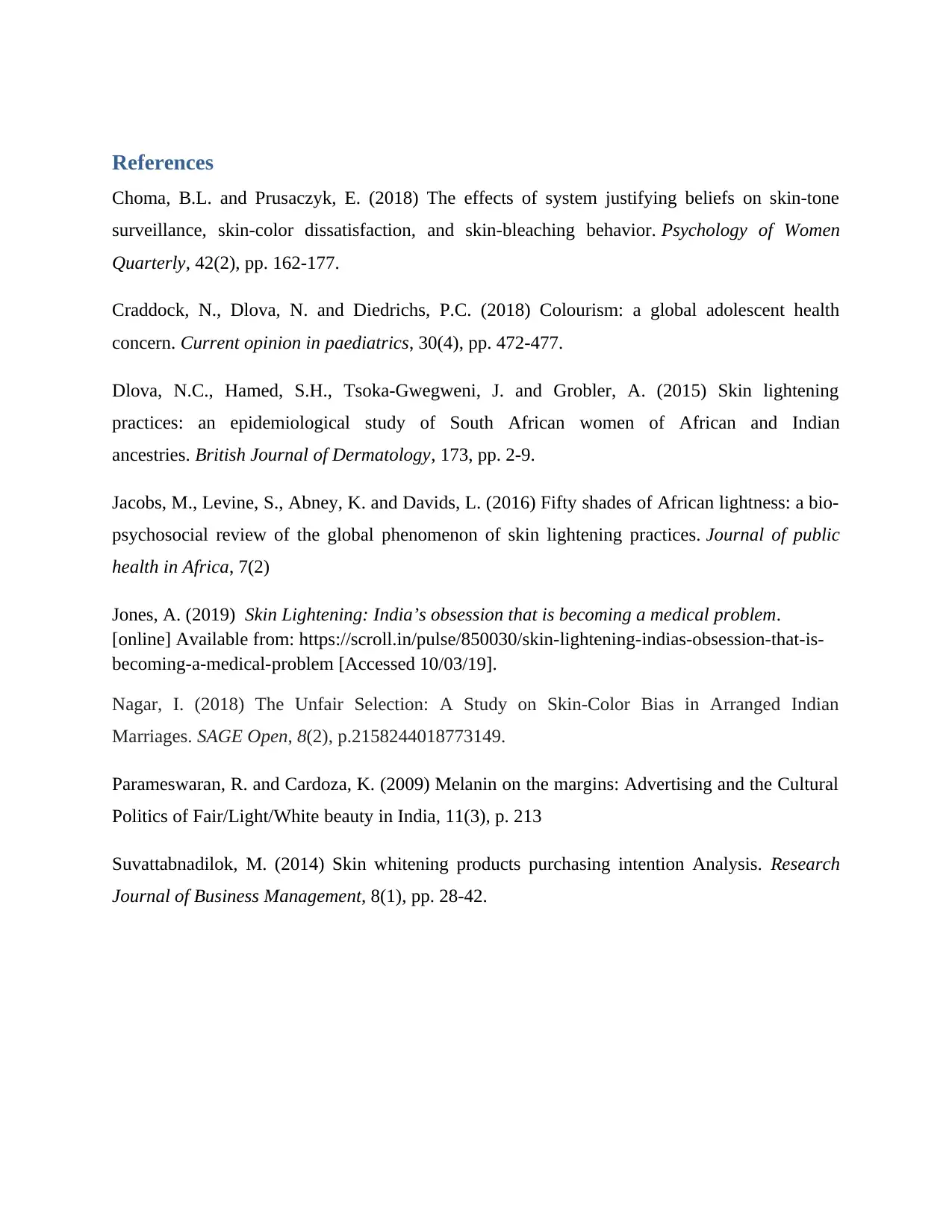Research: Skin Whitening Ads and Mental Health in India - Proposal
VerifiedAdded on 2023/04/25
|6
|1457
|376
Report
AI Summary
This research proposal investigates the impact of television advertisements for skin whitening products on the mental health of individuals in India. The study explores the influence of these advertisements on societal perceptions of beauty, colorism, and self-esteem, particularly among women. It examines the role of the skin fairness product industry in perpetuating racism and social inequality. The research methodology will employ qualitative research methods to analyze the effects of these ads on the thought processes and belief systems of Indian women. The proposal also highlights the significance of the research in understanding the negative effects on mental health and the need for interventions to change perceptions related to skin color. The study references existing literature on colorism, skin-lightening practices, and their impact on adolescents and women in India. The aim is to assess the impact of these businesses on Indian society, analyzing the beliefs of these women regarding their beauty and personal success.

Proposed Research Title
“Analysing the impact of television advertisements of skin whitening products on
the mental health in India”
“Analysing the impact of television advertisements of skin whitening products on
the mental health in India”
Paraphrase This Document
Need a fresh take? Get an instant paraphrase of this document with our AI Paraphraser

Contents
Introduction.................................................................................................................................................4
Literature background.................................................................................................................................4
Aim of research...........................................................................................................................................5
Research methodology................................................................................................................................5
Significance of research...............................................................................................................................6
References...................................................................................................................................................7
Introduction.................................................................................................................................................4
Literature background.................................................................................................................................4
Aim of research...........................................................................................................................................5
Research methodology................................................................................................................................5
Significance of research...............................................................................................................................6
References...................................................................................................................................................7

Introduction
This research proposal addresses the problem related to impact of advertisements of the products
of skin whitening, on the mental health of people in India. The research proposal discusses the
research aim, research question, and possible user of research, potential benefit of research and
importance of research proposal. Additionally, this research proposal demonstrates the research
methodology, and conclusion. The part of research methodology explains the decision of the
methods that will be required to conduct the research task in an effective manner.
Literature background
The main problem is that because of such advertisements, the problem of colourism,
discrimination and other things can arise. The skin fairness product industry has criticized to
perpetuate the racism and social inequality by reinforce beliefs regarding the advantages of skin
fairness for cultural capital.
From the research on the skin whitening creams businesses, it has analyzed that they do big
businesses, and practices amongst the women in India. These businesses found influencing the
physical and mental health of the individual women especially, for the ones who use these
products. According to some authors, it has been determined that skin whitening creams or
products often lead to physical deformities or known as skin burns. These lead to the negative
impact on the mental health of the person, like in the cases when a person’s skin is naturally dark
(Choma and Prusaczyk, 2018)
According to Hemal, Phillippa and Nadia et al (2017) it has analyzed that the women in India are
more particular and conscious regarding their skin color, or glow in the skin. Due to this, they
give importance to the skin-whitening creams introduced by the big fairness companies, and this
creates issues in relation to the context of the views and perceptions of Indian consumers
(Suvattabnadilok, 2014).
Several studies have revealed the concept of colorism, which is central to the lives of adolescents
as a major health concern. It has observed that colorism often privileges those with the lighter
skin, and amongst other racial groups. The issue of colorism often relates or intersects with sex
This research proposal addresses the problem related to impact of advertisements of the products
of skin whitening, on the mental health of people in India. The research proposal discusses the
research aim, research question, and possible user of research, potential benefit of research and
importance of research proposal. Additionally, this research proposal demonstrates the research
methodology, and conclusion. The part of research methodology explains the decision of the
methods that will be required to conduct the research task in an effective manner.
Literature background
The main problem is that because of such advertisements, the problem of colourism,
discrimination and other things can arise. The skin fairness product industry has criticized to
perpetuate the racism and social inequality by reinforce beliefs regarding the advantages of skin
fairness for cultural capital.
From the research on the skin whitening creams businesses, it has analyzed that they do big
businesses, and practices amongst the women in India. These businesses found influencing the
physical and mental health of the individual women especially, for the ones who use these
products. According to some authors, it has been determined that skin whitening creams or
products often lead to physical deformities or known as skin burns. These lead to the negative
impact on the mental health of the person, like in the cases when a person’s skin is naturally dark
(Choma and Prusaczyk, 2018)
According to Hemal, Phillippa and Nadia et al (2017) it has analyzed that the women in India are
more particular and conscious regarding their skin color, or glow in the skin. Due to this, they
give importance to the skin-whitening creams introduced by the big fairness companies, and this
creates issues in relation to the context of the views and perceptions of Indian consumers
(Suvattabnadilok, 2014).
Several studies have revealed the concept of colorism, which is central to the lives of adolescents
as a major health concern. It has observed that colorism often privileges those with the lighter
skin, and amongst other racial groups. The issue of colorism often relates or intersects with sex
⊘ This is a preview!⊘
Do you want full access?
Subscribe today to unlock all pages.

Trusted by 1+ million students worldwide

as a lighter skin tone is assumed as the key component of global beauty. Thus, the practice of
skin lightening in India is identified as serious health issue. Adolescents have observed as critical
period of physiological and sociological development. Therefore, these aspects determine the
impact of the television commercials of the skin whitening creams on the mental health of
women (Craddock, Dlova and Diedrichs, 2018).
The authors in their study, after analyzing the scenario revealed the fact that skin lightening is
considered a psychological and social problem; rather it is more a public health issue. It has been
found that the Indian obsession with the fair skin is obvious and often identified as a major issue
in the Indian society. Women feel their life to be perfect if they have perfect skin, as it creates a
positive attitude in their minds (Dlova et al., 2015). On the other hand, it was observed that the
dark skin colour conflicts with the idea of their beauty and personal success. Thus, the discussion
will enlist the factors or aspects related to the skin color, discrimination, and the impact on the
self-esteem or mental health of women. The issue needs to be addressed with the targeted
interventions specifically to the young and married women in India. Thus, the intervention needs
to be discovered to accomplish the aim of changing the perception of the people towards their
skin color or fairness (Parameswaran and Cardoza, 2009).
Aim of research
The major aim of the research proposal is to find out the influence of TV advertisements related
to the products of whitening the skin, on the mental health of people in India (Jacobs, et. al,
2016). It is observed that the research is mainly based on the assessment of the impact of these
businesses on Indian society, and further analysing the fact which forms the base of
mentalities or belief systems of these women regarding their beauty and personal success.
Research methodology
For analyzing the influence of TV advertisements related to the products of whitening the skin,
on the mental health of people in India, the qualitative research is useful. The qualitative research
will facilitate identifying and observing the usage of the skin whitening and changes in the
though-process and belief systems of Indian women. According to the qualitative research
conducted within Indian society, that one element, i.e. ‘melanin’ is responsible for the colour of
skin lightening in India is identified as serious health issue. Adolescents have observed as critical
period of physiological and sociological development. Therefore, these aspects determine the
impact of the television commercials of the skin whitening creams on the mental health of
women (Craddock, Dlova and Diedrichs, 2018).
The authors in their study, after analyzing the scenario revealed the fact that skin lightening is
considered a psychological and social problem; rather it is more a public health issue. It has been
found that the Indian obsession with the fair skin is obvious and often identified as a major issue
in the Indian society. Women feel their life to be perfect if they have perfect skin, as it creates a
positive attitude in their minds (Dlova et al., 2015). On the other hand, it was observed that the
dark skin colour conflicts with the idea of their beauty and personal success. Thus, the discussion
will enlist the factors or aspects related to the skin color, discrimination, and the impact on the
self-esteem or mental health of women. The issue needs to be addressed with the targeted
interventions specifically to the young and married women in India. Thus, the intervention needs
to be discovered to accomplish the aim of changing the perception of the people towards their
skin color or fairness (Parameswaran and Cardoza, 2009).
Aim of research
The major aim of the research proposal is to find out the influence of TV advertisements related
to the products of whitening the skin, on the mental health of people in India (Jacobs, et. al,
2016). It is observed that the research is mainly based on the assessment of the impact of these
businesses on Indian society, and further analysing the fact which forms the base of
mentalities or belief systems of these women regarding their beauty and personal success.
Research methodology
For analyzing the influence of TV advertisements related to the products of whitening the skin,
on the mental health of people in India, the qualitative research is useful. The qualitative research
will facilitate identifying and observing the usage of the skin whitening and changes in the
though-process and belief systems of Indian women. According to the qualitative research
conducted within Indian society, that one element, i.e. ‘melanin’ is responsible for the colour of
Paraphrase This Document
Need a fresh take? Get an instant paraphrase of this document with our AI Paraphraser

skin and it has been found that skin colouring or whitening agents work by reducing the content
or presence of melanin from the skin of women (Jones, 2019).
Significance of research
The research proposal is significant to the readers as it assured them explaining the value of an
assignment and the expertise. It is required by the readers to be ensure that it is not impractical
part of writing; though, the reflective effort of research, which will be extremely important for
learning. The research contributes a vital role towards analysing the negative effects on the
health, specifically mental health of women in the Indian society. Therefore, the section
presenting a review of literature in the above part of proposal stated that more than 40% of the
women’s mental health was affected after the use of skin whitening creams or products available
in the market such as fair and lovely creams (Nagar, 2018).
Conclusion
To conclude the above discussion it has been analysed that the skin whiteners businesses or
markets in India has continued to rise and grow over years. This has observed due to the reason
of increased favouritism towards the skin whitening products by the young generation and
women within Indian society. Moreover, the industry in India is engaged in making huge
investments in the advertisements and other aspects of the skin whitening creams. Thus, the
above proposal has stated about the impact in terms of the elements such as colorism, and
discrimination, amongst the women in different parts of the country.
or presence of melanin from the skin of women (Jones, 2019).
Significance of research
The research proposal is significant to the readers as it assured them explaining the value of an
assignment and the expertise. It is required by the readers to be ensure that it is not impractical
part of writing; though, the reflective effort of research, which will be extremely important for
learning. The research contributes a vital role towards analysing the negative effects on the
health, specifically mental health of women in the Indian society. Therefore, the section
presenting a review of literature in the above part of proposal stated that more than 40% of the
women’s mental health was affected after the use of skin whitening creams or products available
in the market such as fair and lovely creams (Nagar, 2018).
Conclusion
To conclude the above discussion it has been analysed that the skin whiteners businesses or
markets in India has continued to rise and grow over years. This has observed due to the reason
of increased favouritism towards the skin whitening products by the young generation and
women within Indian society. Moreover, the industry in India is engaged in making huge
investments in the advertisements and other aspects of the skin whitening creams. Thus, the
above proposal has stated about the impact in terms of the elements such as colorism, and
discrimination, amongst the women in different parts of the country.

References
Choma, B.L. and Prusaczyk, E. (2018) The effects of system justifying beliefs on skin-tone
surveillance, skin-color dissatisfaction, and skin-bleaching behavior. Psychology of Women
Quarterly, 42(2), pp. 162-177.
Craddock, N., Dlova, N. and Diedrichs, P.C. (2018) Colourism: a global adolescent health
concern. Current opinion in paediatrics, 30(4), pp. 472-477.
Dlova, N.C., Hamed, S.H., Tsoka‐Gwegweni, J. and Grobler, A. (2015) Skin lightening
practices: an epidemiological study of South African women of African and Indian
ancestries. British Journal of Dermatology, 173, pp. 2-9.
Jacobs, M., Levine, S., Abney, K. and Davids, L. (2016) Fifty shades of African lightness: a bio-
psychosocial review of the global phenomenon of skin lightening practices. Journal of public
health in Africa, 7(2)
Jones, A. (2019) Skin Lightening: India’s obsession that is becoming a medical problem.
[online] Available from: https://scroll.in/pulse/850030/skin-lightening-indias-obsession-that-is-
becoming-a-medical-problem [Accessed 10/03/19].
Nagar, I. (2018) The Unfair Selection: A Study on Skin-Color Bias in Arranged Indian
Marriages. SAGE Open, 8(2), p.2158244018773149.
Parameswaran, R. and Cardoza, K. (2009) Melanin on the margins: Advertising and the Cultural
Politics of Fair/Light/White beauty in India, 11(3), p. 213
Suvattabnadilok, M. (2014) Skin whitening products purchasing intention Analysis. Research
Journal of Business Management, 8(1), pp. 28-42.
Choma, B.L. and Prusaczyk, E. (2018) The effects of system justifying beliefs on skin-tone
surveillance, skin-color dissatisfaction, and skin-bleaching behavior. Psychology of Women
Quarterly, 42(2), pp. 162-177.
Craddock, N., Dlova, N. and Diedrichs, P.C. (2018) Colourism: a global adolescent health
concern. Current opinion in paediatrics, 30(4), pp. 472-477.
Dlova, N.C., Hamed, S.H., Tsoka‐Gwegweni, J. and Grobler, A. (2015) Skin lightening
practices: an epidemiological study of South African women of African and Indian
ancestries. British Journal of Dermatology, 173, pp. 2-9.
Jacobs, M., Levine, S., Abney, K. and Davids, L. (2016) Fifty shades of African lightness: a bio-
psychosocial review of the global phenomenon of skin lightening practices. Journal of public
health in Africa, 7(2)
Jones, A. (2019) Skin Lightening: India’s obsession that is becoming a medical problem.
[online] Available from: https://scroll.in/pulse/850030/skin-lightening-indias-obsession-that-is-
becoming-a-medical-problem [Accessed 10/03/19].
Nagar, I. (2018) The Unfair Selection: A Study on Skin-Color Bias in Arranged Indian
Marriages. SAGE Open, 8(2), p.2158244018773149.
Parameswaran, R. and Cardoza, K. (2009) Melanin on the margins: Advertising and the Cultural
Politics of Fair/Light/White beauty in India, 11(3), p. 213
Suvattabnadilok, M. (2014) Skin whitening products purchasing intention Analysis. Research
Journal of Business Management, 8(1), pp. 28-42.
⊘ This is a preview!⊘
Do you want full access?
Subscribe today to unlock all pages.

Trusted by 1+ million students worldwide
1 out of 6
Your All-in-One AI-Powered Toolkit for Academic Success.
+13062052269
info@desklib.com
Available 24*7 on WhatsApp / Email
![[object Object]](/_next/static/media/star-bottom.7253800d.svg)
Unlock your academic potential
Copyright © 2020–2025 A2Z Services. All Rights Reserved. Developed and managed by ZUCOL.
